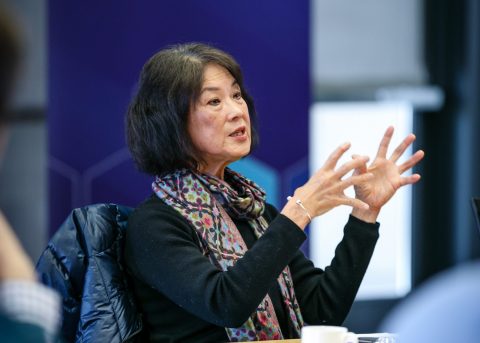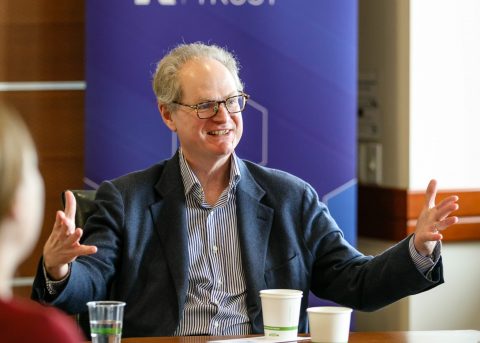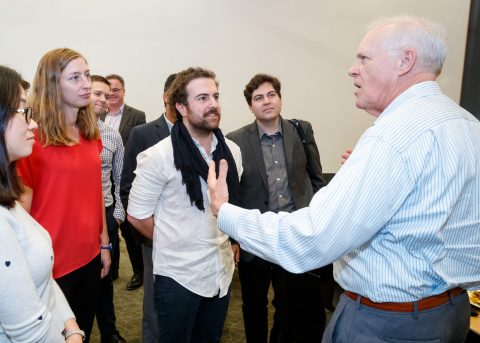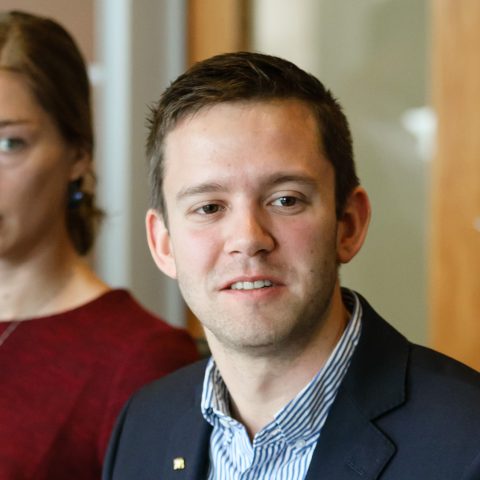So far in my time as a Schmidt Science Fellow, my postdoctoral experience has been everything I dreamed it would be and more. In addition to embarking on new research adventures I couldn’t have even imagined when I began, I’ve made huge strides toward realizing my original project vision of developing new diagnostic tools for personalized medicine. As anyone who’s spoken with me will attest, I am incredibly excited about the potential applications of my technology. But recently, I’ve begun to wonder what a scientist’s role, or even ethical obligation, is in translating his or her discoveries into something that concretely benefits society.
The Global Meeting Series in Northern California focused strongly on this important question. Between panel discussions with professors who had founded their own companies and meeting the who’s who of Sand Hill Road (synonymous with Silicon Valley venture capital firms), we had the rare opportunity to pop open the hood of the world of scientific business and venture capital to take a peek at how things are run on the inside. The program succeeded in demystifying the west coast startup ethos for me but also led me to consider more soul-searching questions about whether the academic or industrial route would best serve the technology that I’m currently building in order to achieve maximal societal impact.
The Schmidt Science Fellows fall on a wide spectrum ranging from the purely academically inclined to those who are considering launching companies. However, we all generally agree that certain projects should unambiguously be spun out of the laboratory. We all know of instances when a research article was published about a technology that promised to change the world, and that was the last anyone heard about it. In a session with Kathy Ku, the former Executive Director of the Stanford Office of Technology Licensing, she warned that academics who failed to secure proper intellectual property rights often doomed their inventions to fester in the pages of academic journals, never to see the light of day.

The sentiment of wanting to translate research into real-world solutions was also shared by Paul Alivisatos, the Executive Vice Chancellor and Provost at UC Berkeley, who reflected on his career trajectory as a professor and founder of several companies saying that fundamentally, he just wanted his work to become meaningful. In the cases where an invention could have profound societal benefits, a company may be the best means to bring a technology to the public.

But is the scientist who makes a meaningful discovery best suited to commercialize it? As in any other professional role, reflection is required. John Hennessy, former Stanford President and current Alphabet Inc. Chairman, said that he asks himself before assuming any new position whether or not he will be able to add unique value.

Over lunch, Naomi Ginsberg, Associate Professor of Chemistry and Physics at UC Berkeley, said that she only pursued research projects that she felt uniquely equipped to perform and shared a clear take-home message that if somebody else can do it, let them do it. Applied to the business world, I take these nuggets of wisdom to mean that scientists should only personally start companies when they feel they have something truly unique to offer the world.
The final headscratcher is how to decide whether to develop a technology purely within an academic sphere or by starting a company. As Alberto Sangiovanni-Vincentelli, Chair of Electrical Engineering and Computer Sciences at UC Berkeley told us, it is fine to try to do both. It’s true that many academics have successfully bridged the academic/industrial divide, retaining active research programs while spinning out companies and serving on their boards. For example, Jennifer Cochran, Chair of Bioengineering at Stanford, founded two companies during a recent sabbatical.
Asked about her experience starting a company as a Stanford Professor, Lucy Shapiro simply explained that she never restricted herself to do one thing or another, but always aimed to do both. Sometimes academics need to serve as the shepherds for their most creative ideas and take the initiative to ensure that their science lives up to its full potential, enjoying the best of both the academic and industrial worlds.
So where does that leave me? After the Global Meeting Series, I feel reinvigorated and empowered. While I’m still riding the wave of exhilarating research as a postdoc, I feel more confident than ever that there are multiple avenues to bring my research ambitions to fruition. For now, I’m going to continue hunting down the translational projects that I find to be the most exciting while keeping in mind that it is ultimately my responsibility to make sure my technology actually finds its way to the clinic. There are a lot of open doors, and I can’t wait to see which one – or ones – my research leads me to walk through.
Learn more about Karl’s research.
Read more about the 2019 Northern California Global Meeting and watch the video.
